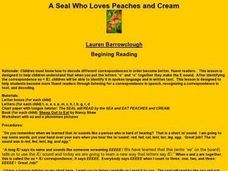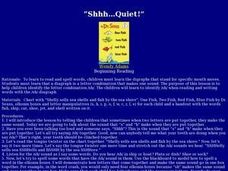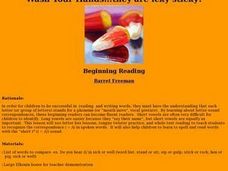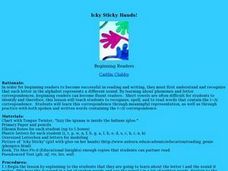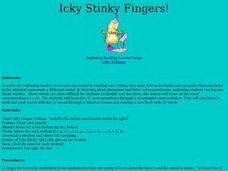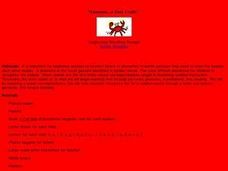Curated OER
"Loud Cows All Around"
Students practice with vowel digraphs and how letters can correspond with phonemes. The activity consists of students learning the ou=/ow/ correspondence in which they will learn in both spoken and written words through reading and...
Curated OER
A? Speak up, I can't hear you!
Students become phonemically aware of various sounds that make up written words. This instructional activity focuses on the vowel correspondence a_e=/A/. They decode the long a mouth moves in words as well as practice spelling the words...
Curated OER
Easter Alliterations
The Easter holiday is explored through alliteration using 5 examples. Learners will also choose 1 of their alliterations to illustrate. Great small group activity too!
Curated OER
Here Kitty, Kitty
Learners recognize the short vowel i in written and spoken language. Through matching activities, they discriminate the short vowel /i/ from other vowel sounds. Students associate the phoneme with its letter representation and identify...
Curated OER
The Very Hungry Caterpillar
Learners explore phonemes and short vowels. They identify /a/ (short a) sound in spoken words and learn a meaningful representation and a letter symbol for the sound. Students identify /a/ (short a) sound in words. They read "The Very...
Curated OER
Dinosaur Alliterations
In this alliteration activity, students review the definition and an example for alliterations. Students then write their own alliterations about dinosaurs and illustrate one of their examples in the box.
Curated OER
Sammy the Slimy Snake
Young scholars engage in a emergent literacy instructional activity with the intention of improving reading comprehension. The goals of the instructional activity include recognizing both upper and lower case S, to create an awareness of...
Curated OER
Alligator Open Wide
First graders recognize the short vowel a in written and spoken language. Through listening activities, they discriminate the vowel sound /a/ from other phonemes. Students associate the phoneme with its letter representation and identify...
Curated OER
Unopened Umbrella
Students explore vowel correspondences. They discuss the vowel correspondence u=/u/. They identify u=/u/ in written words and a meaningful representation and letter symbol for the sound. Students read and write words using u=/u/.
Curated OER
Shiny Shells on the Shore
Students investigate how: A single phoneme, which is a vocal gesture in spoken words, can be represented by more than one grapheme. Also how a digraph is the combination of two letters that make one sound (there are both vowel and...
Curated OER
Icky Sticky Tin Man
Students recognize the short vowel i in written and spoken language. Through listening and matching activities, they discriminate the vowel sound /i/ from other phonemes. Students associate the phoneme with its letter representation and...
Curated OER
A Seal Who Loves Peaches and Cream
Young scholars decode correspondence in order to become better, fluent readers. When the letters e and a are put together they make the E sound. They become more fluent readers through listening for a correspondence in speech, in text,...
Curated OER
Shhh! Quiet!
Students become aware that when certain letters are put together in a word they are said with a single mouth move. Through modeling and a variety of guided practice activities they explore the /sh/ phoneme. They read and identify 'sh'...
Curated OER
U-u-under The U-u-umbrella!
Students practice using phonemes because they need to be able to recognize that phonemes and letters correspond with each other in order to become a proficient reader. The practice is done using the letter "u".
Curated OER
Pink Puffy Pig
Students participate in an emergent literacy lesson based upon the skill of phonemic awareness. They recognize the grapheme p in text, hear the phoneme /p/ in spoken words, and write the upper and lower case form of p by my modeling.
Curated OER
Wash Your Hands...they are icky sticky!
Students engage in an emergent literacy instructional activity that focuses on phonemic awareness and they practice corresponding the letter "i" to its long or short sound. This type of recognition has been found to be essential to...
Curated OER
Icky Sticky Hands!
Students examine the letter 'i'. Through instruction and modeling they explore the sound the letter makes, how the letter is written, words that contain the letter, etc. They use letterboxes to write 'i' words and read stories containing...
Curated OER
Opera Singer
Students recognize the short vowel o in written and spoken language. Through listening and decoding activities, they discriminate the vowel sound /o/ from other phonemes. Students identify the phoneme and letter in pseudo words they read.
Curated OER
Icky Stinky Fingers!
Students examine the letter 'i'. Through instruction and modeling they explore the sound the letter makes, how the letter is written, words that contain the letter, etc. They use letterboxes to write 'i' words and read stories...
Curated OER
Icky Fingers
Students are introduced to digraphs so they can match letters to their phonemes. They recognize the short vowel i=/i/ in both spoken and written words by practicing reading and spelling words containing /i/. Elkonin Letter Boxes are...
Curated OER
"Aaaaaaa...a Fast Crab! "
Students participate in an emergent literacy lesson that focuses on the skill of phonemic awareness. The phoneme chosen is the letter "a". They need to correlate the sound to the letter.
Curated OER
Chicka, Chicka, Choo, Choo
Students begin to read and spell words vis phonemes and letter correspondences. They encounter the concept digraph. This lesson plan helps the students see a c and h together, they make the ch sound. So, that the students recognize this...
Curated OER
Shhhhelly Shhhhrimp
Students read and spell words via alphabetic insight that letters stand for phonemes and spelling. They map out the phonemes in spoken words. This instructional activity will help students identify the letters s and h, along with the...
Curated OER
Adam's Apples
Students examine the /a/ phoneme in both written and spoken words. They practice finding the /a/ in words, watch how their mouths move when making the sound, and write the letter. Next, they differentiate the sound in words, listen to a...













